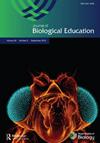利用半沉浸式虚拟植物实地考察考察学生的植物实地工作经验
IF 1.4
4区 教育学
Q3 BIOLOGY
引用次数: 0
摘要
实地教学是植物学和生态学的重要组成部分;然而,在COVID-19大流行的早期阶段,实地教学是最有可能被取消的课程之一。可用于满足植物学学习成果(如植物鉴定、测量技能发展)的虚拟替代方案在当时基本上是不可用的。为了解决这个问题,使用H5P开发了一个半沉浸式虚拟植物实地考察。该资源包括一个360度的实地考察,一本带有一系列互动视频的互动书籍来模拟样方分析和植物鉴定,以及一个植物鉴定指南来帮助学生识别物种。学生们对该资源的反应大多是积极的,尽管他们明显倾向于以更传统的方式亲自进行实地考察。该资源是第一个这样的虚拟植物实地考察,并允许保留传统实地课程的大多数学习成果。这类资源在大流行后的世界具有相当大的潜力,可以扩大参与,让学生体验他们可能没有机会调查的生态系统。该资源可在CC BY-NC-SA许可下使用。《生物教育杂志》(Routledge)版权归Routledge所有,未经版权所有者明确书面许可,其内容不得复制或通过电子邮件发送到多个网站或发布到listserv。但是,用户可以打印、下载或通过电子邮件发送文章供个人使用。这可以删节。对副本的准确性不作任何保证。用户应参阅原始出版版本的材料的完整。(版权适用于所有人。)本文章由计算机程序翻译,如有差异,请以英文原文为准。
Investigating student experiences of botanical field work using a semi-immersive virtual botanical fieldtrip
Field teaching is an essential component of botany and ecology;however, field classes were among the most likely to be cancelled during the early stages of the COVID-19 pandemic. Virtual alternatives that could be used to meet learning outcomes for botany (e.g. plant identification, surveying skills development) were largely unavailable at this time. To address this, a semi-immersive virtual botanical fieldtrip was developed using H5P. The resource consists of a 360 site tour, an interactive book with a series of interactive videos to mimic quadrat analysis and plant identification, and a plant identification guide to aid students in identifying species. Students responded largely positively to the resource, although they had a clear preference to undertake fieldwork in person in a more traditional manner. The resource is the first such virtual botanical fieldtrip and allows the retention of most learning outcomes for a traditional field class. This type of resource has considerable potential in a post-pandemic world to widen participation and let students experience ecosystems that they might otherwise not have the opportunity to investigate. The resource is available for use under a CC BY-NC-SA licence. [ FROM AUTHOR] Copyright of Journal of Biological Education (Routledge) is the property of Routledge and its content may not be copied or emailed to multiple sites or posted to a listserv without the copyright holder's express written permission. However, users may print, download, or email articles for individual use. This may be abridged. No warranty is given about the accuracy of the copy. Users should refer to the original published version of the material for the full . (Copyright applies to all s.)
求助全文
通过发布文献求助,成功后即可免费获取论文全文。
去求助
来源期刊
CiteScore
3.00
自引率
27.30%
发文量
68
审稿时长
>12 weeks
期刊介绍:
Journal of Biological Education is firmly established as the authoritative voice in the world of biological education.
The journal aims to bridge the gap between research and practice, providing information, ideas and opinion, in addition to critical examinations of advances in biology research and teaching. Through the coverage of policy and curriculum developments, the latest results of research into the teaching, learning and assessment of biology are brought to the fore.
Special emphasis is placed on research relevant to educational practice, guided by educational realities in systems, schools, colleges and universities. Papers that are theoretically informed and methodologically rigorous are welcomed.

 求助内容:
求助内容: 应助结果提醒方式:
应助结果提醒方式:


